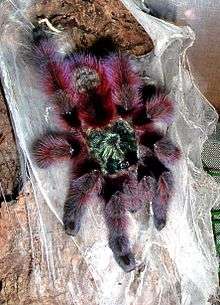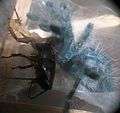Antilles pinktoe tarantula
| Martinique pinktoe tarantula | |
|---|---|
 | |
| Scientific classification | |
| Kingdom: | Animalia |
| Phylum: | Arthropoda |
| Subphylum: | Chelicerata |
| Class: | Arachnida |
| Order: | Araneae |
| Infraorder: | Mygalomorphae |
| Family: | Theraphosidae |
| Genus: | Caribena |
| Species: | C. versicolor |
| Binomial name | |
| Caribena versicolor (Walckenaer, 1837)[1] | |
| Synonyms[1][2] | |
| |
The Antilles pinktoe tarantula (Caribena versicolor), also known as the Martinique red tree spider or the Martinique pinktoe is popular as a spider pet because of its docile character and unique coloration.
Previously placed in the genus Avicularia, C. versicolor is native to Martinique in the Caribbean Sea.[2]
Antilles pinktoe tarantulas are arboreal (tree-dwelling). They spin elaborate funnel webs in which they spend most of their time.
Spiderlings of C. versicolor are bright blue, with a black tree trunk pattern on the abdomen. As they grow, they gradually lose their blue coloration; the carapace turns green, the abdomen red, and the legs turn green with pink tarsi and a covering of purple hairs. Males usually are slightly more brightly colored than females. As in most tarantula species, males do not grow as large as females, and their abdomens are smaller than those of females, even in proportion to their size.
Taxonomy
Mygale versicolor was first described by Charles Athanase Walckenaer in 1837.[1] In the description, Walckenaer used a female he said was from Guadeloupe and a male from Brazil. However, the two actually belong to different species. This causes nomenclatural problems, since when later workers synonymized Mygale versicolor or transferred it to another genus, they may have ultimately based their decisions on either the female or the male. Caroline Fukushima and Bertani in 2017 treated Mygale versicolor as the female specimen (actually believed to be from Martinique), designating a neotype. On this basis, it is synonymous with Avicularia rutilans. It was transferred to the genus Avicularia by Eugène Simon in 1892 and to the new genus Caribena in 2017.[2]
Care
This tarantula requires a delicate balance of good ventilation and high humidity. A terrarium with a screen top and side venting, light daily misting achieves that balance. The Antilles do well at a temperature of around 75 degrees F, but will tolerate temperatures ranging from 60 to 82 degrees F. They enjoy high humidity- ideally between 70 and 80 percent relative humidity. In captivity, cage height is much more important than floor space. Decor consists of tree branches or cork pieces to which the spider can attach its web.
Feeding
The Antilles pinktoe is an aggressive feeder and will eat anything from crickets, worm, grasshoppers, cockroaches, beetles, moths, and other flying insects, to anole lizards. They will also take mealworms and moth larvae, but these have to be given sparingly due to their fat percentage and the calcium-phosphorus proportions.
Temperament
Antilles pinktoes are naturally docile, although they are quick and can jump up to 30 cm or more. Along with many other members of the subfamily Aviculariinae, they possess type II urticating hairs, which they use for defense, but unlike terrestrial new world tarantulas they generally do not kick them, choosing to instead press them against the perceived threat when used. Bites from this type of spider are rare, if provoked it flees. Bites are not dangerous; comparable to a wasp sting.
Enclosure
A setup highly recommended for these arboreal species is providing it with plenty of objects in the enclosure to climb around. This enclosure has to also be well ventilated, else this results in mildew and mold. Since these tarantulas are arboreal (living in tree), they are more inclined to make their webs closer towards the top of the enclosure. For this reason, it is highly recommended to purchase an enclosure that opens from the side, not the top. This prevents unnecessary stress unto your pet tarantula when opening the enclosure.
Gallery

 Versicolor baby is blue. Coin size at the background is 15mm in size.
Versicolor baby is blue. Coin size at the background is 15mm in size.
References
- 1 2 3 "Taxon details Caribena versicolor (Walckenaer, 1837)", World Spider Catalog, Natural History Museum Bern, retrieved 2017-03-15
- 1 2 3 Fukushima, C.S. & Bertani, R. (2017), "Taxonomic revision and cladistic analysis of Avicularia Lamarck, 1818 (Araneae, Theraphosidae, Aviculariinae) with description of three new aviculariine genera", ZooKeys, 659: 1–185, Suppl. 1–5, doi:10.3897/zookeys.659.10717
External links
- Caring for Avicularia versicolor
- Tarantulas of the Genus Avicularia
- Photos of Avicularia versicolor and other 13 Avicularia species in gallery of tarantulas.
- Antilles Pink Toed Tarantula - description
- Avicularia Versicolor | Martinique Pink Toe Tarantula Care
| Wikimedia Commons has media related to Avicularia versicolor. |